“con.Text”
Ink on panel portraits
In this series I portray individuals as the embodiment of strength and pride standing in the face of oppression by a power against them.
I research and reference texts from government documents and use the words as my mark to render each person with the very words that affect them. Using the word as a building block does not label or define the subject by the words being used, instead the words are blended together and they are transformed from a label to a broader gesture that is used to define a new visual standard of vitality and beauty.
“Grandfather” 60″ x 37″ ink on panel 2018

This is a portrait of my grandfather drawn from a photograph taken by Dorothea Lange when she was commissioned to photograph Japanese Americans being interned during the start of the US entry into World War II. This shot was taken in San Francisco as my grandfather and his family was waiting to board a bus for an internment camp in Utah. My grandfather and grandmother were immigrants from Japan, but my father and his brothers were born and raised in San Francisco.
The words used to make the marks that compose this portrait are the text from Executive Order no 9066, which was an Executive Order signed by FDR that established military areas excluding those of Japanese descent and establishing the internment camps away from the West Coast.
Detail:

For more: Information
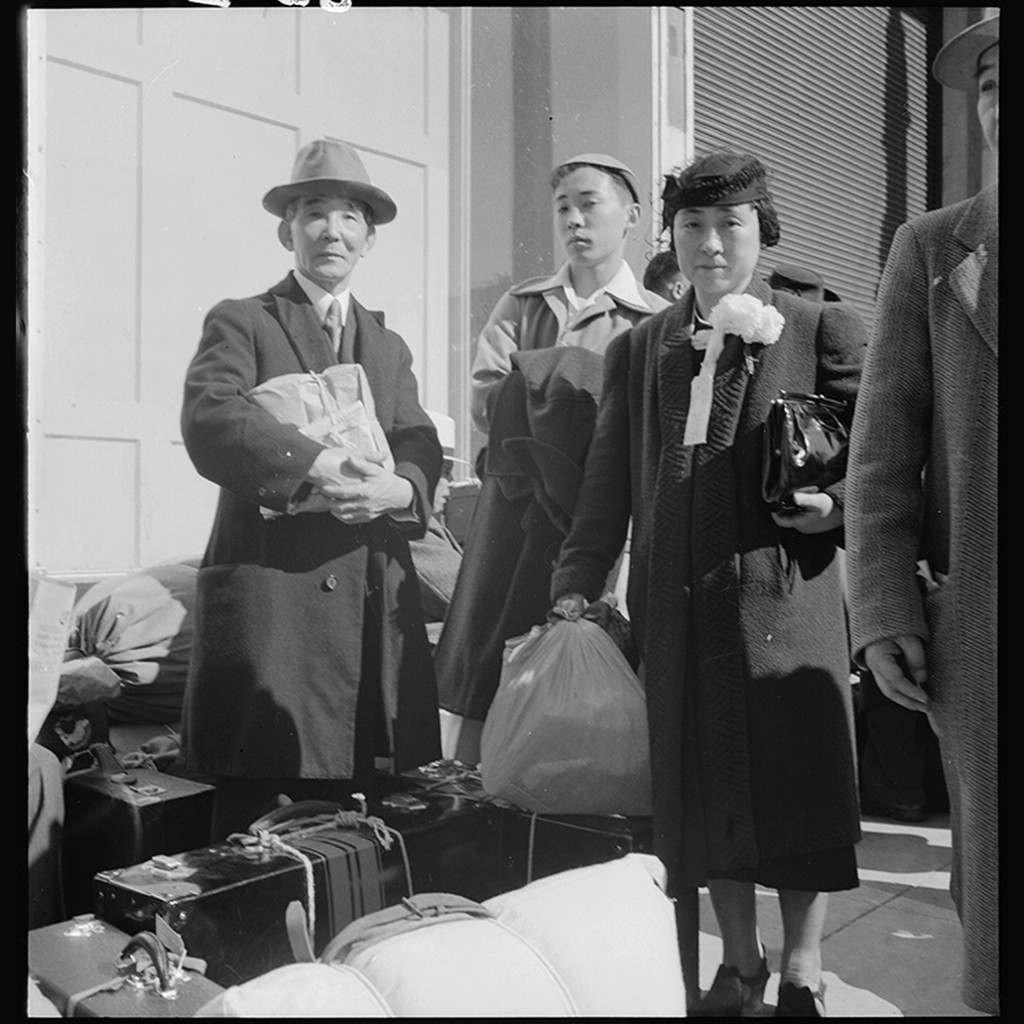
“Grandmother” 60″ x 37” ink on panel 2023
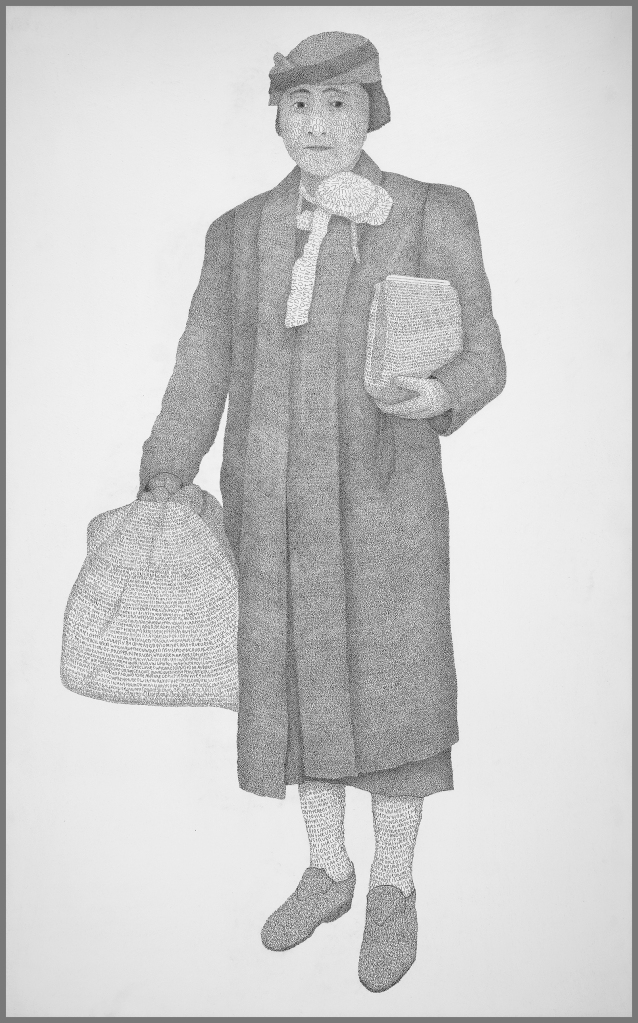
This is a portrait of my grandmother, inspired by the same photograph as my grandfather’s portrait, taken by Dorothea Lange when she was commissioned to photograph Japanese Americans being interned during the start of the US entry into World War II.
The words used to make the marks that compose this portrait are the text from the Immigration Act of 1917, which barred most immigration from Asia. The late 19th century saw the rise of “Yellow peril” the perceived threat of Asian societies replacing the American identity which led to a series of immigration acts in the late 1800s early 1900s. There was the Chinese exclusion act of 1882, the Gentlemen’s Agreement of 1907, the Immigration Act of 1917, and the Immigration act of 1924, that were aimed exclusively at Asian immigration.
Detail:
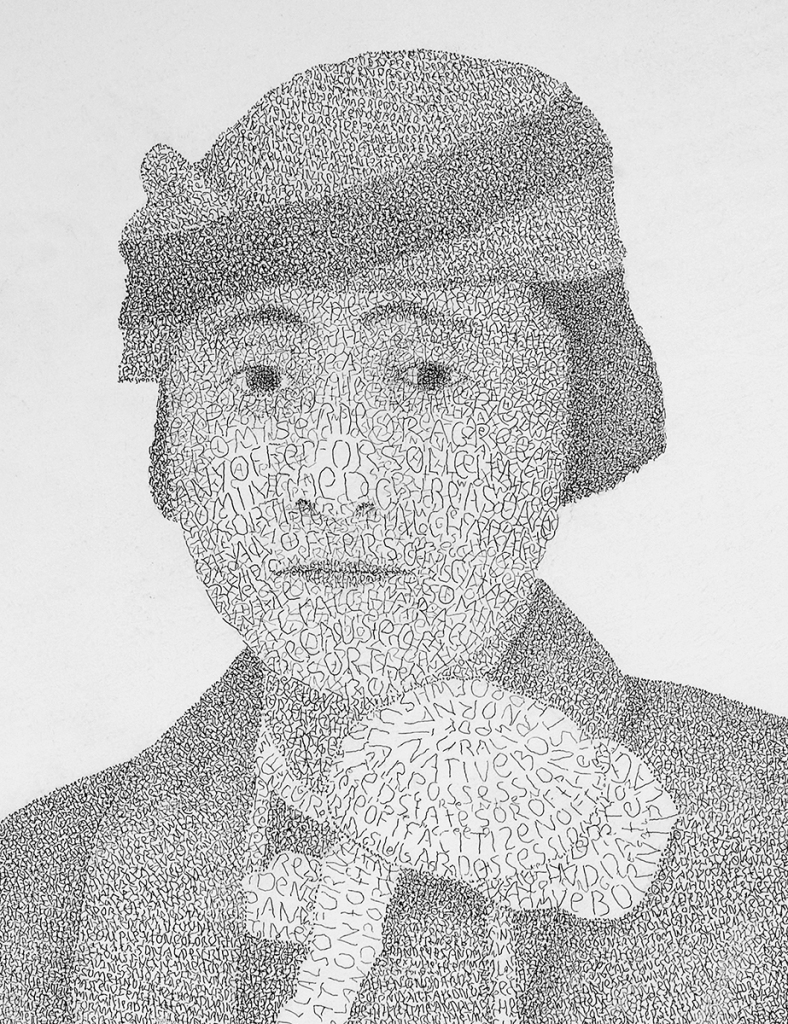
“Neighbor” 60″ x 37″ ink on panel 2018

The idea behind this portrait is to express the spirit of the times in a visual language that is not obvious and has some nuance. This is a portrait of my neighbor in my apartment building as she is going to her Mosque for worship. A simple act of freedom made more difficult by the words and actions of our government.
The marks are made from me writing out all of Trump’s tweets from inauguration day January 20th, 2017 to September 25th, 2017, 1550 entries. I had intended to do a year of tweets but I stopped on September 25th because I felt the piece was done and it did not need any additional weight or shading.
Detail:

For more: Information
“Elon” 60″ x 37” ink on panel 2019

Elon states, “My father survived the Holocaust but lost his entire immediate family. His mother and two sisters were victims of an SS roundup and mass execution. His father was killed by Ukrainian militia, right in front of him. It’s my responsibility to bear witness for all of them.”
The words used to render the portrait are the Nuremberg Race Laws of 1935. The Nazis implemented these laws to ostracize, discriminate and expel Jews from German society.
Detail:

For more: Information
“Gregory” 60″ x 37” Ink on panel 2021
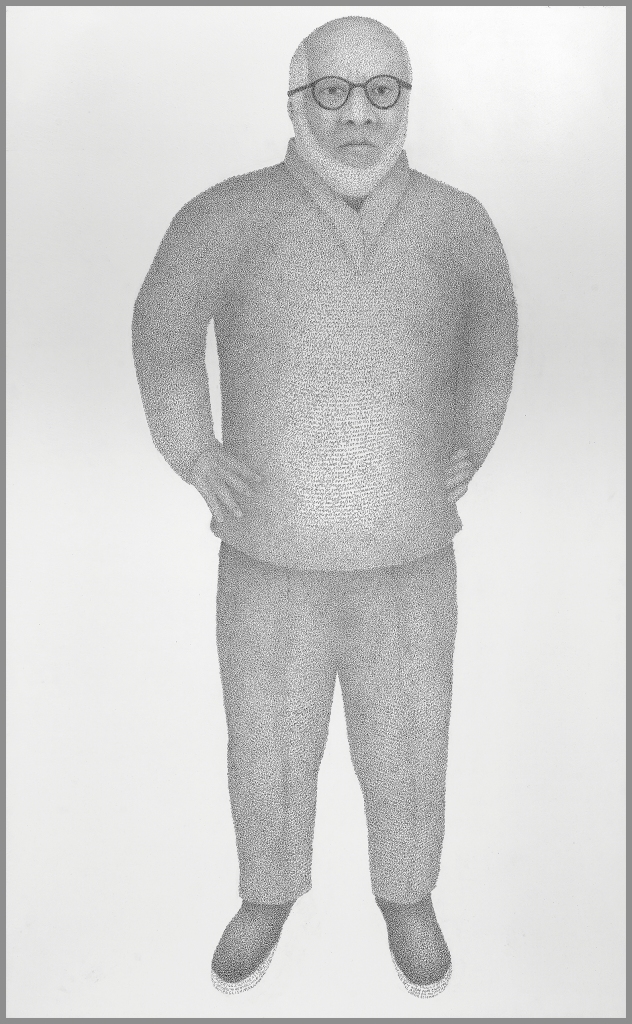
Gregory’s great, great, great, grandmother “Frankie” was sold into slavery at the Manchester Slave Docks in what is now Ancarrow’s Landing on the James River in Virginia in the 1840’s.
Slavery was first brought to America in 1619 in the colony of Virginia and grew into the 1700’s to become the dominant labor system on plantations.
During the 1660s Virginia adopted laws specifically designed to denigrate blacks. These laws banned interracial marriages and sexual relations and deprived blacks of property. The text is from four of those laws from Virginia State Law.
Detail:
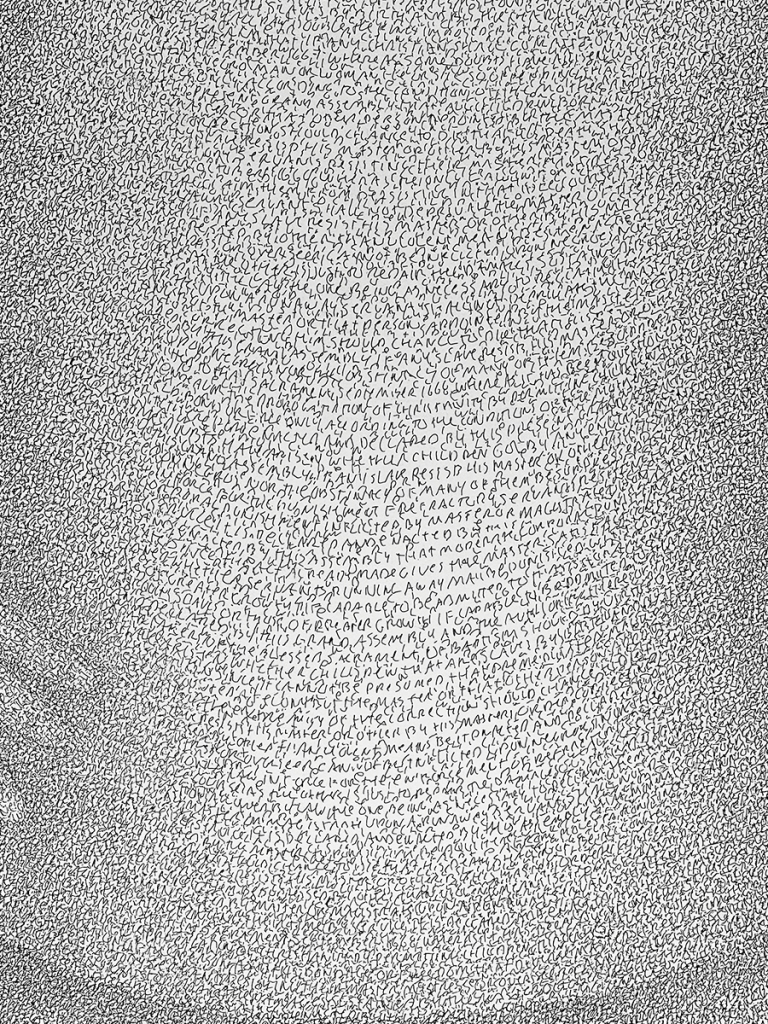
“Paul” 60″ x 37” ink on panel 2019

Paul is the grandson of Juanita ”Holy-named Woman” Left-Hand. Juanita, a Native American woman was one of the last speakers of the dialect spoken by her tribe, the Assiniboine. Born around 1896, she witnessed the long battle to maintain traditional Indian life on the reservation as it was fought and lost. Juanita was overjoyed when historians came to ask her help in transcribing the dialect and the traditional Indian stories and their accompanying hand gestures. Those transcriptions, as well as her traditional beadwork designs and dolls now reside in the Smithsonian Institution Archive.
The text is the Indian Removal Act of 1830, which mandated all Indian Nations in the southern states to be relocated west of the Mississippi. This document was one of the opening salvos to the systematic dismantling of native cultures and that relocation resulted in what is known as the “Trail of Tears” which decimated the populations of the southern Indian Nations
Detail:

For more: Information
“Lorraine” 60 x 37 Ink on panel 2021

Lorraine’s great grandfather first came to the United States in the 1850’s on a 30ft Sampan, a Chinese fishing vessel not designed to cross an ocean. He landed in Mendocino County and immediately began work in the lumber camps as a cook. After going to China in the late 1880’s he tried to return to his family in California, but due to the Chinese Exclusion Act of 1882 he had to pay to take the name of a U.S. citizen to be allowed back to his family in California
The text used to render the portrait is The Chinese Exclusion Act of 1882, which was the first and only law to prevent all members of a specific ethnic group from immigrating to the United States. Many Americans on the West Coast attributed declining wages and economic ills to Chinese workers so Congress passed the Exclusion Act to placate worker demands and assuage prevalent concerns about maintaining white “Racial Purity”
Detail:
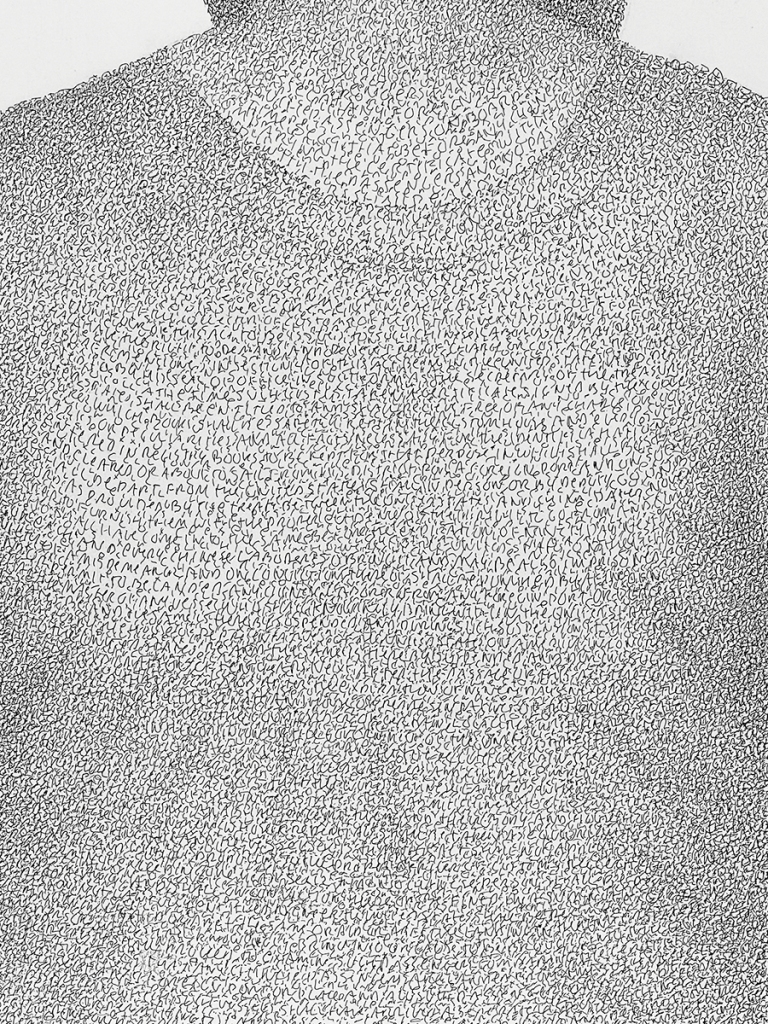
“Lisa” 60 x 37 Ink on panel 2021
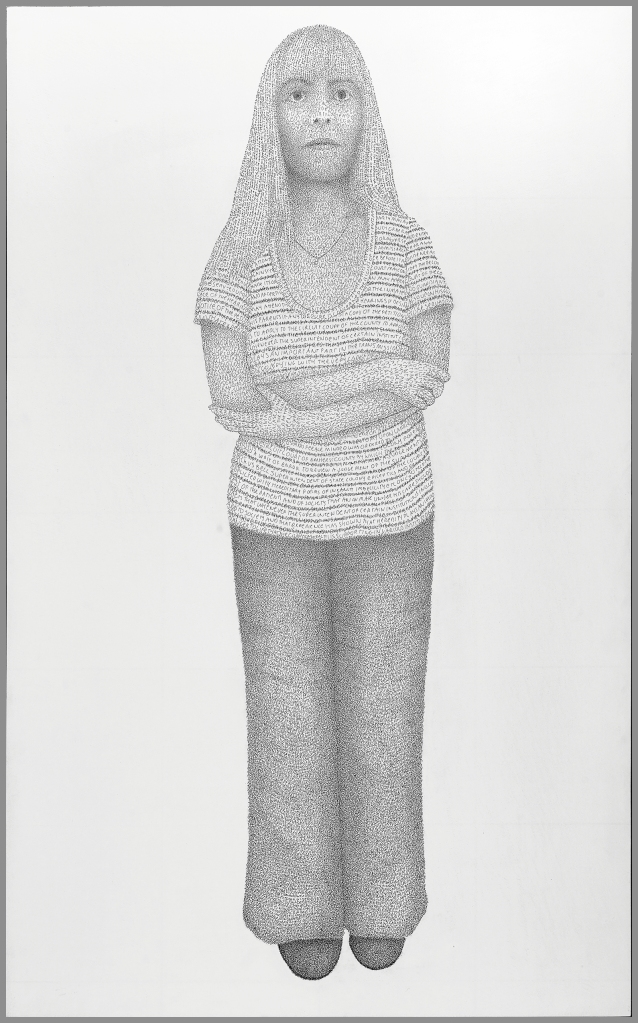
Lisa was born with a condition called Arthrogryposis. It is a stiffness of the joints and small under developed muscles in the body and in her case it affected all four limbs.Doctors initially thought she would never walk, but by 3 years old she was walking. At school her mom had to petition for her to get into the classroom as there were no accommodations for children with special needs.With the passage of the Rehabilitation act of 1973, which prohibited discrimination against those with disabilities in federally funded programs, Lisa’s school began providing services for the disabled.
The Americans with Disabilities Act of 1990 went further in reach to prohibit discrimination against those with disabilities.
The text is the 1927 U.S. Supreme Court case, Buck v. Bell, which set a legal precedent that individual states may sterilize inmates of public institutions. The court argued that imbecility, epilepsy, and feeblemindedness are hereditary, and that inmates should be prevented from passing these defects to the next generation.
Detail:
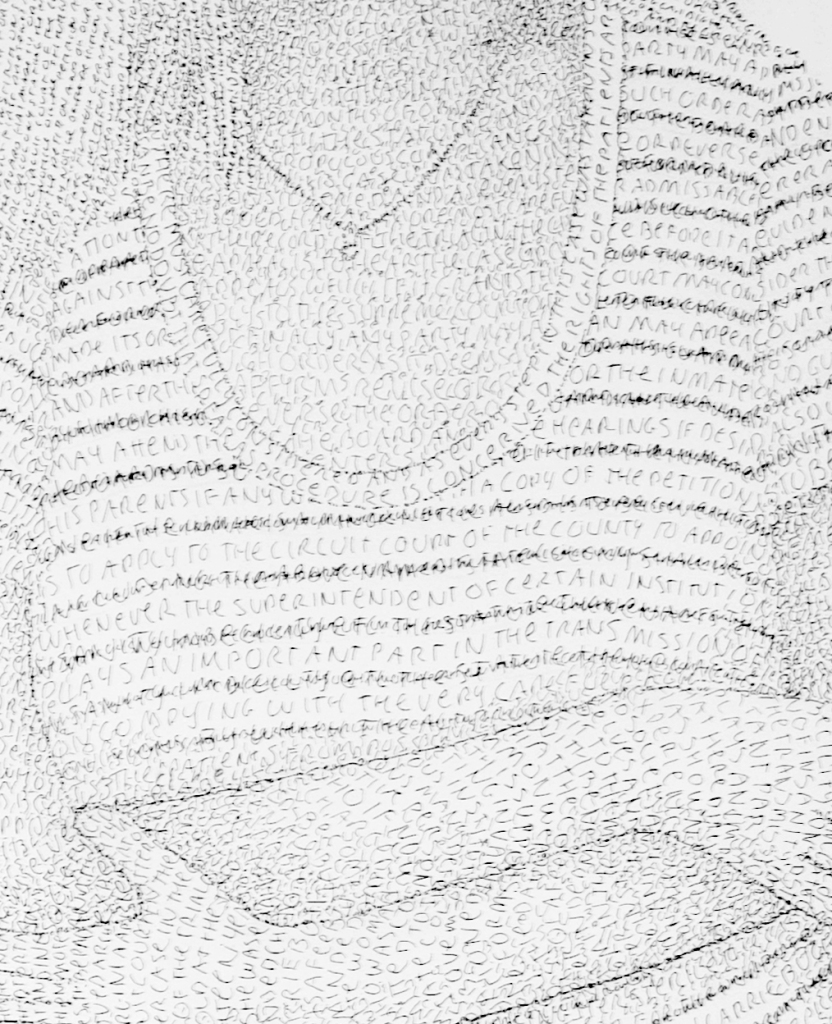
“Mike” 60″ x 37” Ink on panel 2019

Mike was drafted into the U.S. Army in 1968 during the Vietnam War. He served in the 1st Calvary as a helicopter gunner and was shot down by an enemy hand held rocket 8 months into his deployment. He was medically discharged.
The text is the Gulf of Tonkin Resolution of 1964 that authorized the use of conventional military ground forces in Vietnam without a Declaration of War by Congress. 1968 was the year of the Tet offensive by the North Vietnamese that proved to be the turning point of the United States involvement in Vietnam
Detail:

For more: Information
“Justine” 60″ x 37” Ink on panel 2019

In the 1930’s Justine’s great grandmother moved her family from New York to the Watts neighborhood in south Los Angeles amid a backdrop of intense racial discrimination. One of the many faces this discrimination took was in the form of housing covenants and deed restrictions that restricted minorities from living in many parts of Los Angeles. They were limited by covenants as well as a narrow access to institutional financing known as “redlining”. These covenants were a part of southern California housing since the late nineteenth century and they were struck down partially in 1948 and then completely in 1953.
The words I chose to use in the formation of this portrait are sections from current residential deeds that still to this day contain the covenants restricting ownership to whites only, though they lack any legal standing. I also chose to use the words from the landmark Civil Rights Act of 1964.
Detail:

For more: Information
“Ash” 60″x37” Ink on panel 2019

Ash rediscovered her sexuality while in college and finally made the choice to come out with the support of her sister. Since then she has become a speaker, activist and advocate of the LGBTQ community.
The text is Executive Order 10450 from 1953 that used broad language to ban homosexuals from working in the federal government notably the armed services. The Executive Order was part of a larger movement that included mass firings in the 1950’s and was referred to as the “Lavender Scare” which was discrimination based on sexual orientation. The “Lavender Scare” worked in parallel with the “Red Scare” of the same time period that targeted communism in the United States.
Detail:

For more: Information
“Mary Jo” 60″ x 37” Ink on panel 2019

Mary Jo had an abortion at age 21 when she didn’t feel she could provide what was necessary emotionally or financially to raise a child on her own. Without legalized abortion women will risk their life to have the freedom to make decisions about their bodies and the way they live their own lives.
Prior to 1821 abortion was legal in all 50 states. In 1821 Connecticut was the first state to ban abortion. The text is made up of two pieces the first is the statute from the bylaws of the State of Connecticut from 1821 which banned abortions. The second is the Comstock Laws of 1873, which was the first federal law to address abortion. This Act criminalized usage of the U.S Postal Service to send items related to abortion.
Detail:

For more: Information
“Heather” 60″ x 37” Ink on panel 2020
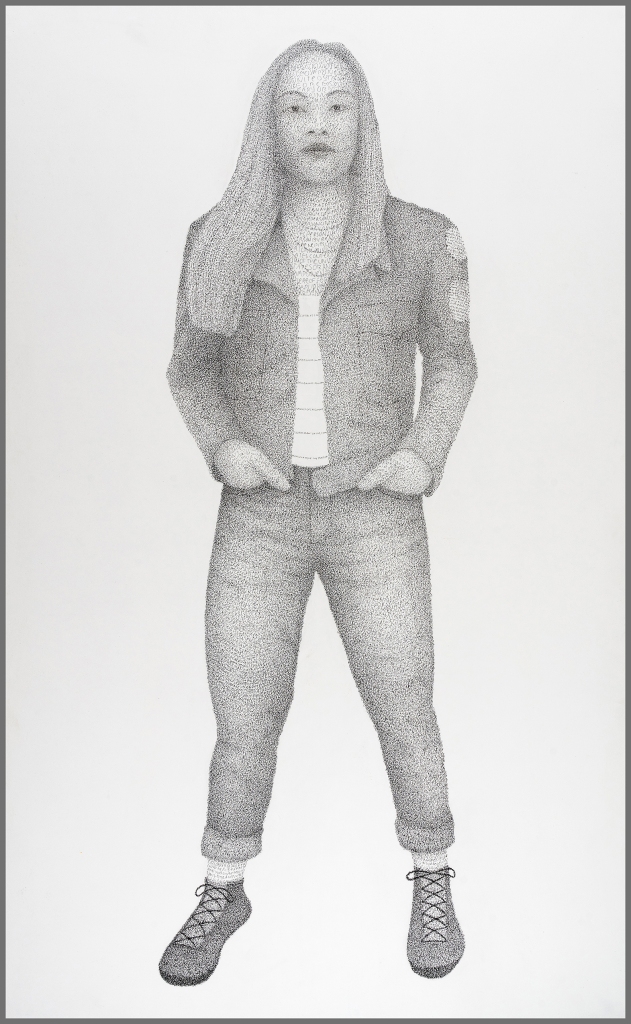
Heather is a 1st Lt serving in the United States Air Force. Her grandfather Silvino Parcasio served in the Philippine scouts from 1927-1945 when in 1942 he was captured by the Japanese Imperial Army forced into the Bataan Death March and imprisoned. Upon liberation by the United States in 1944 he enlisted in the US Army in 1945 and served until 1962.
Many of Silvino’s compatriots, who were American Nationals by way of the Philippines being an American Commonwealth, were federalized to fight with the US Army in 1941 when the Japanese invaded the Philippines and were promised U.S. military benefits and services. In 1946 the U.S. government rescinded those military benefits to those that chose to return to civilian life.
The text is the Rescission Act of 1946 that annulled benefits promised to the Philippine Scouts.
Detail:
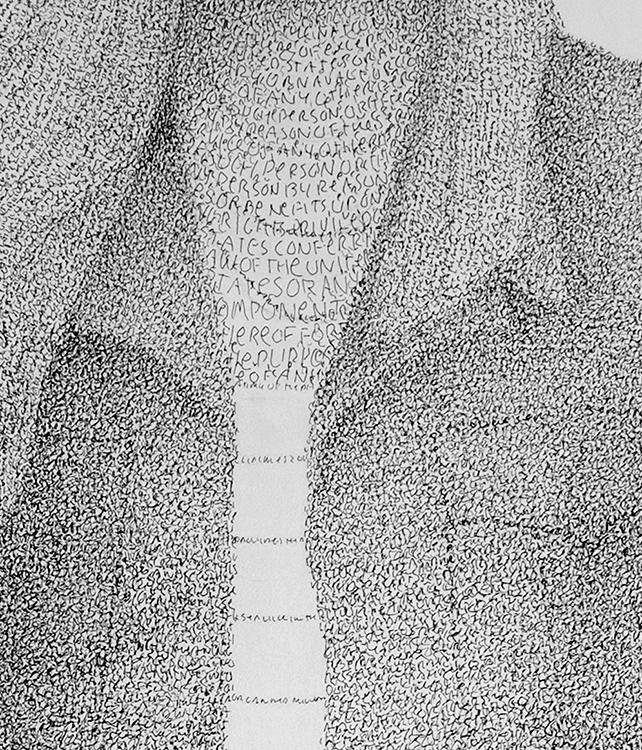
For more: Information
“Tiffany”
60″ x 37″ Ink on panel 2020
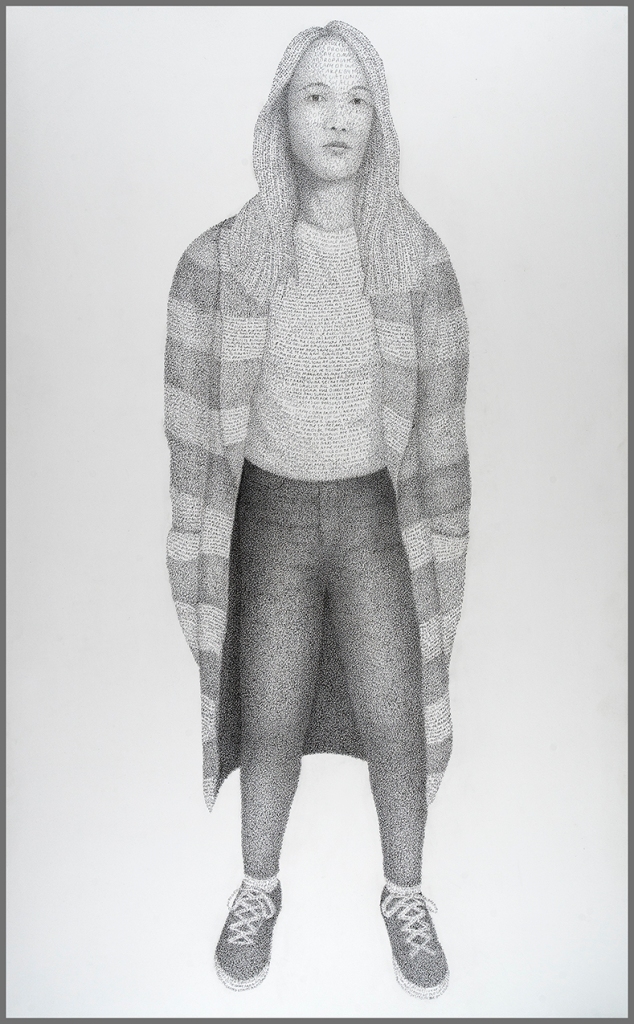
Tiffany is the granddaughter of Roy Sakasegawa who was drafted into the U.S. army in August 1941 from Salinas CA four months before Pearl Harbor. After the attack Roy’s family was incarcerated along with 120 thousand people of Japanese descent, 62% were American, in Poston Arizona one of the 10 internment camps set up to house the internees.
Roy went on to serve in the 442nd Infantry division composed of Japanese Americans who fought mostly in Europe. The 442nd Regiment is the most decorated unit for its size in U.S. Military history. The unit earned more the 18,000 awards including 21 Medal of Honor.
The text used to make the marks is Executive Order 9102 that established the War Relocation Authority the agency responsible for the forced relocation and internment of Japanese Americans during WWII.
Detail:
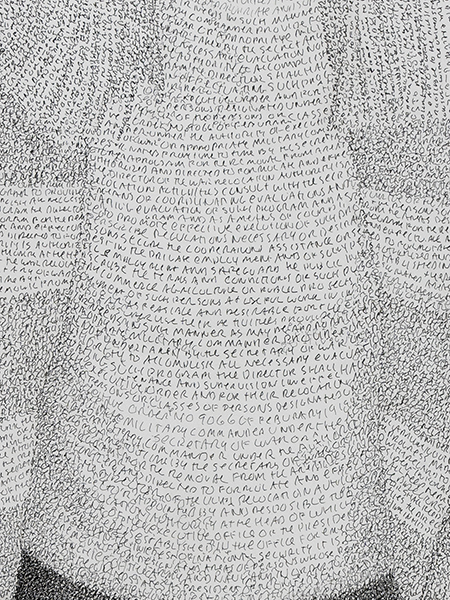
For more:
“Protester”
60″ x 37″ ink on panel 2019

This is an image from my friend Elon Shoenholz’s photo archive where he documents the protest marches that have occurred since the elections of November 2016. She was photographed in the first protest march following the elections in downtown Los Angeles. The power of her stance and the words on her shirt express the defiance and anger the marches represent.
The marks that form the drawing are the words of the Declaration of Sentiments from 1848, which was a declaration based on the Declaration of Independence, that renounced the government at that time because it did not recognize women as equal. The Declaration of Sentiments is one of the first documents to claim equal rights for women and it marked the beginning of the women’s rights movement.
Detail:

For more:
“Marcus”
60″ x 37″ ink on panel 2019

I met Marcus sleeping on the streets of Los Angeles at the corner of Venice Blvd and West Ave and I started thinking about homelessness and the feeling of being powerless. I knew I wanted to draw him and wanted to depict him as an equal in the eyes of our government.
I chose to use the text from the Bill of Rights as my mark as it reaffirms the ideas of individual rights and equality that are the values upon which our nation was built. But, by portraying him seated, filling half the frame allows him to represent the inequity that is the reality of our unfulfilled potential
Detail:

For more:
“Blaine”
60″ x 37″ Ink on panel 2019

This is my brother Blaine. He died by a gun 15 years ago. He and I grew up shooting in youth clubs and his passion throughout his life was competitive target shooting.
The words are the NRA Bylaws.
Detail:

For more:
“Angelin”
60″ x 37″ Ink on panel 2019

Angelin is the U.S. born daughter of friends of mine who are first generation Mexican Immigrants.
The text is the Chinese Exclusion Act of 1882. After the Chinese labored to build the transcontinental railroad that opened the Western states to expansion as well as being excluded from the Gold Rush of the 1850’s the U.S. government moved to ban all Chinese immigration to the U.S. in 1882. It was the first law to exclude an entire ethnic group from immigrating to the US.
Detail:

For more:
“Father”
45″ x 36″ ink on panel 2020
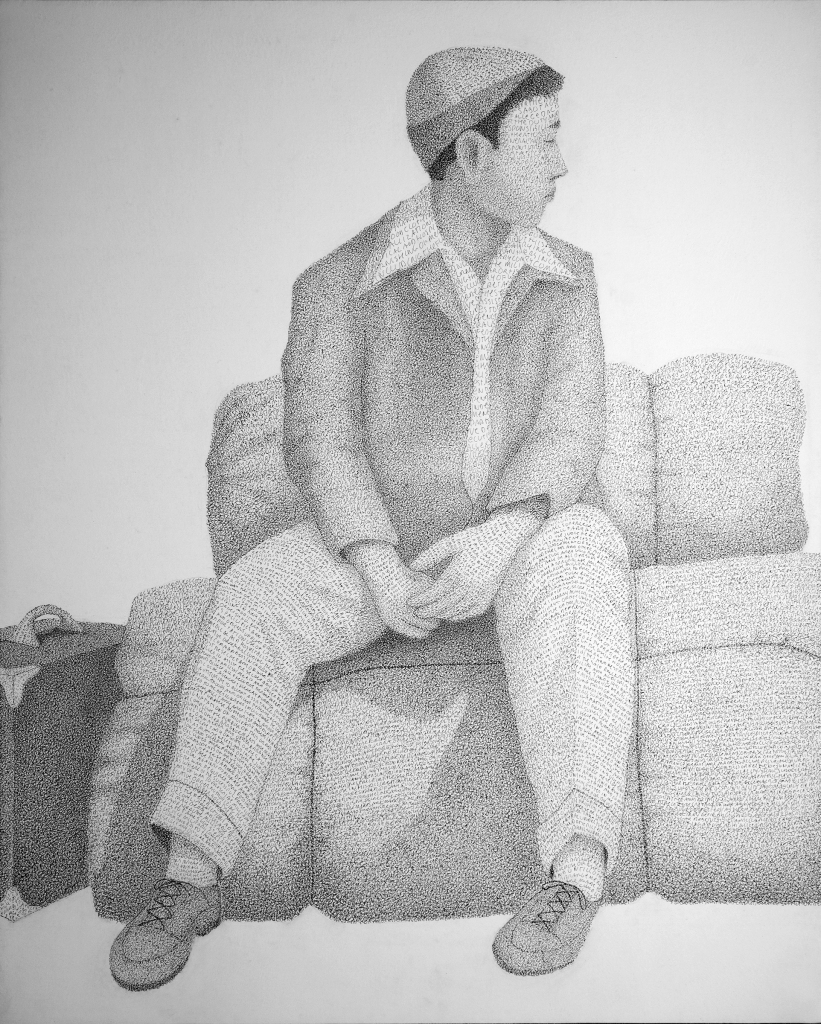
This is a portrait of my father based on a photograph taken by Dorothea Lange of the Japanese American Internment during WWII. He was interned and enlisted in the Army and served with the Military Intelligence Service in the Pacific Theatre.
The text used is Executive Order 9066 which justified the internment of the Japanese Americans from the West Coast.
Detail:
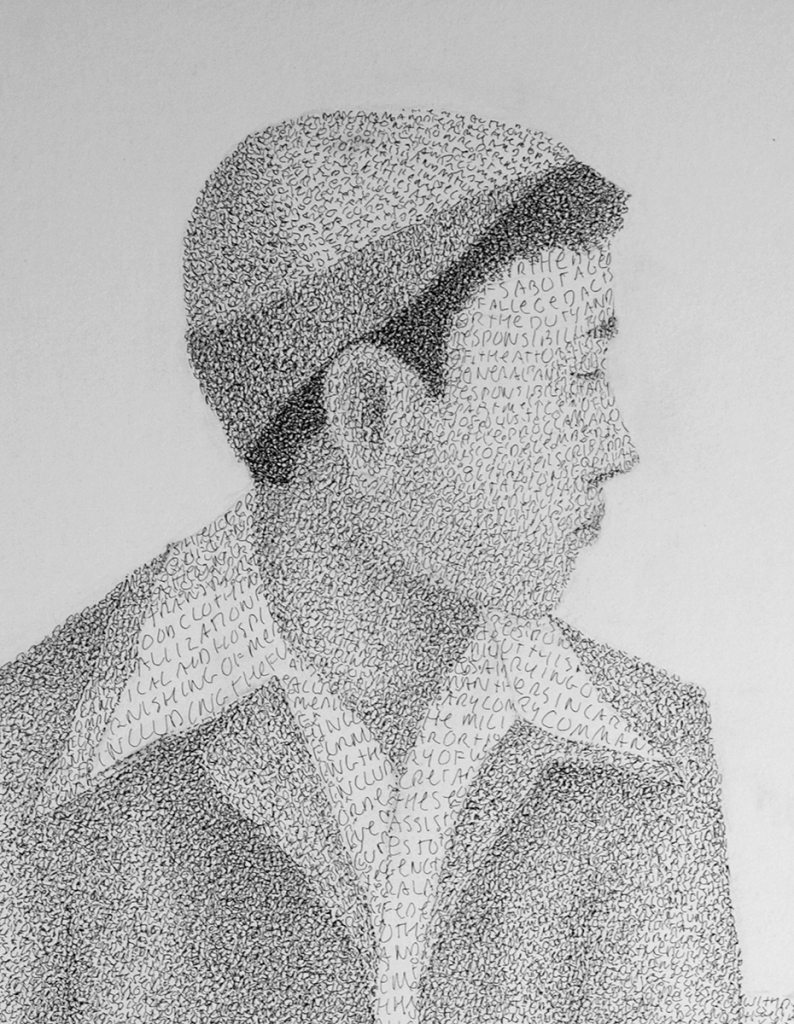
For more:
“Manzanar”
36 x 48 Ink on panel 2020
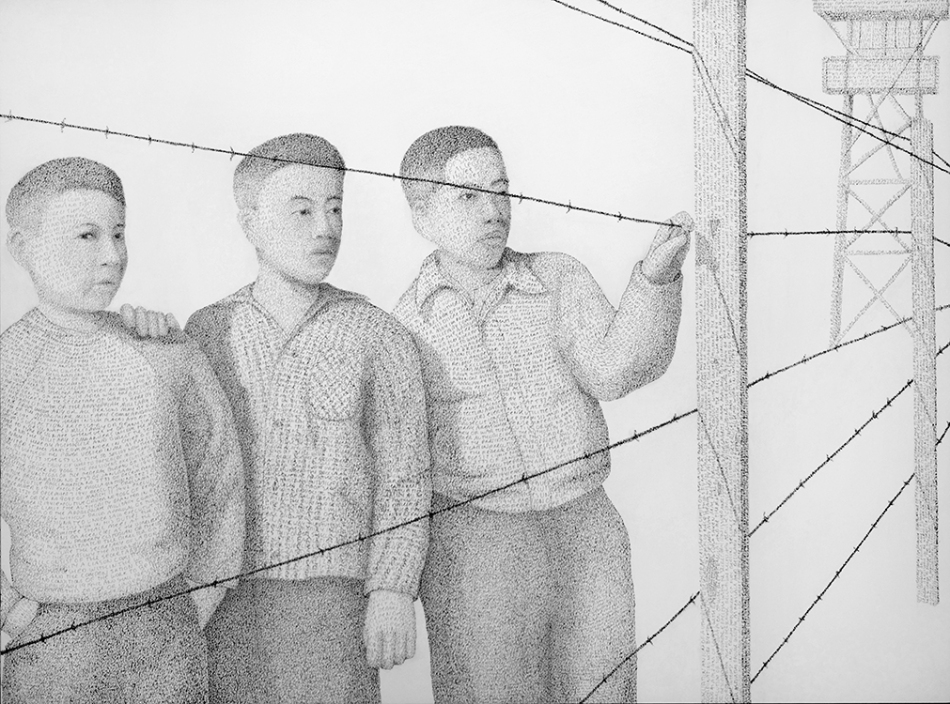
Using one of Toyo Miyatake’s iconic photographs from Manzanar as a reference I utilize words as my mark to reinterpret his image to show strength in the face of oppression.
The words are Executive Order 9066 which authorized the imprisonment of West coast Japanese Americans and Executive Order 9102 which established the War Relocation Authority who oversaw the internment.
Detail:
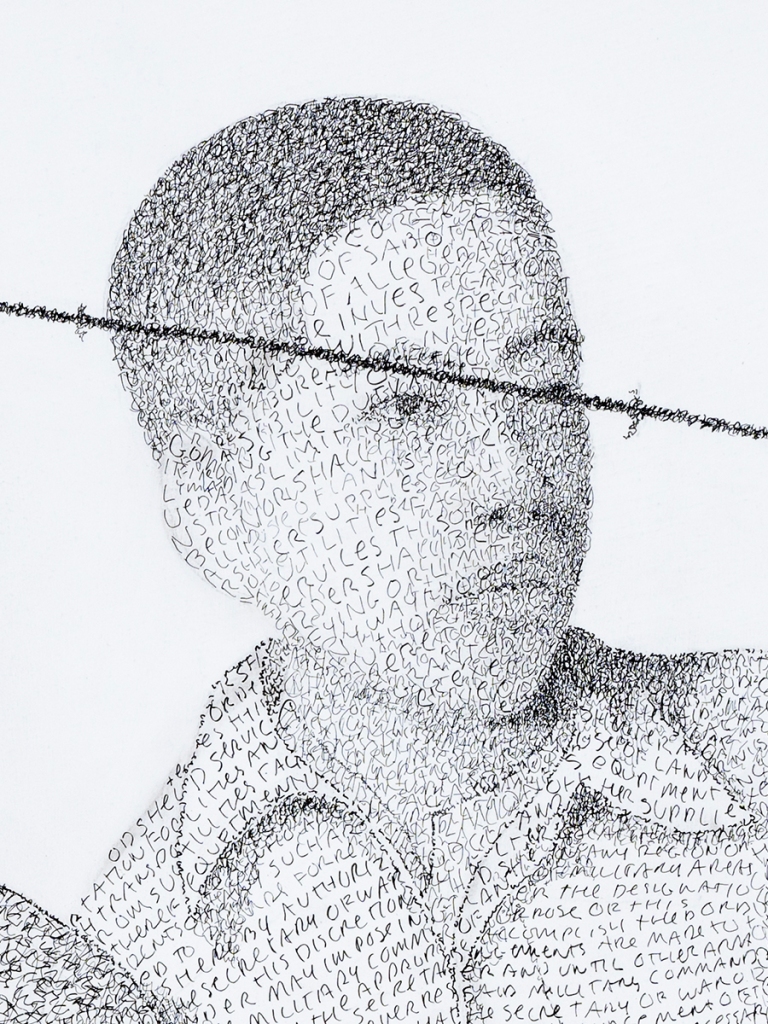
For more:
